–
真本達摩易筋經
AN AUTHENTIC DEPICTION OF DAMO’S YIJINJING
金倜盦
by Jin Ti’an [Tisheng]
[published Sep, 1936]
[translation by Paul Brennan, March, 2020]
–
序
PREFACE
易筋經為少林武術祖師達摩禪所傳授。分內外二經。內經主柔。以靜坐運氣為事。非少林正宗弟子。不得其傳。且擅此者。亦不肯輕易授人。守少林戒也。後之練武者。欲自眩耀。往往皆以十二段錦之法代之。以其段數相同。法則相類也。其實十二段錦自十二段錦。易筋經自易筋經。兩經可互證而不可相混者也。至于外經。則主剛。以强筋練力為事。其法遍傳于世。惟眞本亦殊不多遘。坊間俗本。所載各段。節數雖相同。其法實大有出入。欲覓完善之本。不可得也。大抵此法盛行于北方。茲編各法。乃得之於山西藥商鄒仲達君之秘授。據云為少林山陝支流之眞傳。較尋常坊本為勝也。其法偏重于上肢。實為練力運氣。舒展筋脉之妙法。每日依法勤行四五次。百日之後。則食量增加。筋骨舒暢。百病不生。至一二年後。則非但身體强健。精神飽滿。且兩臂之力。可舉千斤。卽為平素孱弱多病。力不足以縛雛者。練習一二年。亦可以一掃其孱弱。兩臂增數百斤之力。至若年老之人。精氣已衰。勤習此法。雖不足以返老還童。亦足以延年却病。江右老人稱明志。年已八旬。精神猶如壯年。日徒步三十里不為苦。嘗為余曰。予氣體素弱。中年多病。從友人之言。勤習易筋經後。不久卽康健。四十年中。從未為病魔所擾。今猶能强健步者。謂非易筋經之功乎。觀乎老人之言。則此法之效力。可以知之矣。茲將其法繪圖列說。印行于世。以公同好。且為坊間俗本。一正其訛也。倜庵識。
The art of Yijinjing [“Sinew Changing Classic”] was passed down from the Zen master Damo, founder of the Shaolin school of martial arts. It is divided onto an internal version and an external version.
The exercises of the internal version emphasize softness, using techniques of meditation and energy movement. It is not genuine Shaolin and should not be taught as such. Masters of it are unwilling to casually teach it to people anyway and guard it as a Shaolin secret. Martial arts practitioners who just want to look more sophisticated are often practicing Shi’erduanjin [“Twelve Sections of Brocade”] instead, which has the same number of exercises and has similar principles, but is actually a different art, and although they are related, they must not confused for each other.
As for the exercises of the external version [the subject of this book], it emphasizes hardness, using techniques for building up the sinews and developing strength. This version has been widely spread, but I have not seen many authentic books about it. There are many versions of it to be found in book stalls, but although they are all the same thing, there are actually huge differences between them. We may hope to find a definitive book, but there just isn’t one.
Generally speaking, this art is more popular in the north. The various exercises in this book are the secret teachings of Zou Zhongda, a pharmacist from Shanxi. According to him: “This is the true transmission of this Shaolin art as it was spread into Shanxi and Shaanxi. It is superior to the more common versions that have been published in books.” These exercises lay particular emphasis on the upper limbs, but are nevertheless an excellent means of training strength and the movement of energy, as well as stretching the sinews and vessels.
I have practiced these exercises diligently, four or five times a day. After the first few months, it boosted my appetite, my muscles and bones felt extremely comfortable, and various illnesses no longer threatened me. After a couple of years, not only was my body much healthier and my spirit full of vigor, my arm strength had increased so much that I could lift very heavy weights. My inherent disposition toward frailty, frequent illness, and inadequate strength had been fully conquered. A couple of years will be sufficient to sweep away frailty and make the arms capable of lifting hundreds of pounds.
Old age is going reduce vitality anyway, but by conscientiously practicing this art, although it will not transform you into a young person again, it will nevertheless prevent illness and prolong life. An old practitioner of it in Jiangxi became known as “Clear Determination”. He is now eighty years old, but his spirit is still like that of a young man, and he walks ten miles every day without any difficulty at all. He said to me: “When I was middle-aged, my body was weak and often ill. A friend recommended to me that should I take up Yijinjing, so I did, and after practicing it diligently, I quickly became healthy. For forty years now, I have not yet been bothered by any illness, and I still walk with confident strides. If this isn’t because of Yijinjing, then what?” From this old man’s words, we can know the effectiveness of this art.
I am about to send my drawings and explanations for these exercises to the publishers
in order to send this art out into the world and share it with enthusiasts, and also to provide a means of correcting the errors in other books on the subject.
- written by Jin Ti’an
–
眞本達摩易筋經外經
EXTERNAL YIJINJING
–
△第一段
Section 1:
面東而立。兩足分開。相距約一尺地。須要平直。不可作八字形。凝神調息。目宜睜視。口宜緊閉。頭宜上昻。鼓氣于腹。兩手上提。肘微屈。兩掌向地。惟兩臂之力。必須下注。如按物踴身之狀。然後用力將手指向上翹起。掌跟卽用力向下一按。如此一翹一按。是為一度。共行四十九度而止。須默數牢記之。式如第一圖
Stand facing toward the east, your feet about a foot apart, pointing straight and parallel rather than with the toes turned outward. Focus your mind and regulate your breath. Your eyes should be open, your mouth should be closed, and your head should be upright. Rouse energy in your abdomen. Your hands lift up, the elbows slightly bending, the palms facing toward the ground, then the strength of your arms has to focus downward, as though pushing on something in order to raise your body up. Your fingers should lift up with tension and then the heels of your palms should push down with tension. Lift up and push down in this way for a total of forty-nine times, counting silently in your head. See drawing 1:

倜按
Commentary:
此段乃混元一炁之勢。先天之象也。行時指上翹宜速。掌下按宜緩。全神貫注于指掌之間。使力足而氣沛。一翹一按。妙合陰陽。若神氣渙散。力不專注。行之無功。此為最忌。兩手上提時。肘雖微屈。惟以手掌至腰下為度。若提過腰。則有損筋骨。學者宜愼也。
This exercise is a posture of connecting to one’s primordial energy, of returning to one’s innate nature. Your fingers should lift quickly and then the palms should push down slowly. Alternating your full attention between fingers and palms causes you to have increased strength and abundant energy. Lifting up and pushing down is a subtle merging of the passive and active aspects. If your spirit is scattered and your strength is not focused, the exercise will not produce results, and so this is something to avoid. When your hands lift up, your elbows slightly bend, keeping palms below waist level. If your hands lift higher than your waist, this will diminish the results of the exercise. Be mindful of this point.
–
△第二段
Section 2:
行前段畢。調息片時。使周身筋骨舒展。然後更續行第二段。正立如前。兩足緊並。肘挺直。十指屈轉握拳。置大腿前面。兩拇指相向。掌心貼腿。然後將拳一緊。拇指卽向上用力翹起。愈高愈妙。于握拳翹指之際。兩臂之力。須向下注。如抵物狀。如此一握拳一翹指。是為一度。默數牢記。共行四十九度而止。行時宜凝神靜氣。專心一念。式如第二圖。
Continuing from the previous exercise, take a moment to regulate your breath, causing your body to relax, then continue into Section 2. Still standing straight, bring your feet together. Your arms straighten, your fingers curl to make fists, which are placed in front of and against your thighs, your thumbs aligned toward each other. Then your fists tighten and your thumbs strongly lift up, the higher the better. As your fists grip and your thumbs lift, the strength of your arms should be focused downward, as if resisting against an object. Perform this gripping and lifting for a total of forty-nine times, counting silently in your head. During the exercise, your spirit should be concentrated and your energy should be calm, your mind focused on the single thought of performing the exercise. See drawing 2:

倜按
Commentary:
此段練指力。握拳宜緊。翹指宜速。臂力下注作抵物狀者。使力聚于拳指。俾拳能愈握愈緊。而指能愈翹愈高也。坊本有將兩拳貼大腿兩旁。而以拇指向前者。殊不得勢。勢不合則力不充。力不充則氣不凝。精神渙散。祇見其謬誤耳。學者宜明辨之。
This exercise develops finger strength. Your fists should grip tightly and your thumbs should lift quickly. Arm strength bearing downward as though resisting against something causes strength to gather in the fists and thumbs, making your fists able to grip more tightly and your thumbs able to lift higher. Other versions have the fists to the sides of the thighs and the thumbs pointing forward, but that is not as effective, for the strength expressed is not as full, and thus the energy is not as concentrated. If your spirit is lacking, the exercise will feel false, and so you have to clearly distinguish between the different versions in order to obtain the one that is most authentic.
–
△第三段
Section 3:
行前段畢。調息片時。更行第三段。身正立如前。兩足分開。相距約一尺。宜平直。不能作八字式。閉口睜目。兩手先曲拇指于掌心。然後以餘指緊之。使成雙拳。直垂于左右。拳背向外。初不必用力。但臂不宜使彎曲耳。然後將拳緊緊一握。臂時向下一挺。使肘節突出。全力聚于拳臂之間。如此拳一握。臂一挺。是為一度。默數牢記。共行四十九度而止。式如第三圖。
Continuing from the previous exercise, take a moment to regulate your breath, then continue into Section 3. With your body still standing upright, your feet spread to be about a foot apart, pointing straight and parallel rather than with the toes turned outward. With your mouth closed and your eyes open wide, first wrap your thumbs over your fingers to again make full fists and hang them straight down at your sides, the backs of the fists facing outward. It is not necessary to exert much strength in the beginning, but keep your arms from bending. Your fists then squeeze and your arms straighten downward, causing your elbows to turn inward as you fill your fists and arms with tension. Perform the exercise in this way, your fists squeezing and your arms straightening, for a total of forty-nine times, counting silently in your head. See drawing 3:

倜按
Commentary:
此段練拳臂之力。兩足分開。所以固下盤也。握拇指于中。所以實拳心。而易于着力也。臂向下挺。至肘節內突。則全身之力。皆聚于臂而達于拳。故曰此段練拳臂之力也。
This exercise develops arm strength. With your feet spread apart and your lower body therefore in a more solid position, your thumbs grip to make full fists and you exert strength, your arms straightening downward until your elbows are pointing inward. The strength of your whole body is thus gathered into your arms and reaches to your fists, and this is the way that this exercise develops arm strength.
–
△第四段
Section 4:
行上段畢。略息片時。更續行此段。先將兩足緊並。全身正立如第一圖。曲拇指于掌心。然後以餘指握之成拳。從下向前緩緩舉起。拳背向外。兩拳心相對。相距與肩闊相等。拳高亦以齊肩為度。上體不能動搖。然後將拳緊緊一握。兩臂乘用力一伸。在伸握之時。若拳臂向左右宕動。是為切忌。如此拳一握。一伸為一度。默數牢記。共行四十九度而止。式如第四圖。
Continuing from the previous exercise, take a moment to regulate your breath, then continue into Section 4. First bring your feet together, your body still standing upright. With your fingers and thumbs grasping as full fists, your fists go forward, slowly lifting up until at shoulder height, the backs of the fists facing outward, the centers of the fists facing each other, shoulder width apart. Your upper body must not wobble. Your fists then squeeze tightly and your arms reach out with tension. While squeezing and reaching, your arms must not drift off to the sides. Squeeze and reach for a total of forty-nine times, counting silently in your head. See drawing 4:
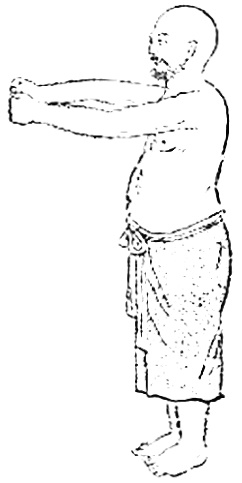
倜按
Commentary:
此段乃練肩背拳臂之力。蓋握拳伸臂。雖力聚于拳臂。而每一伸臂時。兩肩必向前聳。肩向前聳。則背部之筋骨。必現緊張之象。其力不運而自至矣。若兩臂于舉動之時。不能專運其力。而任其宕動。則勢亂神散。徒行無益也。是宜切戒。
This exercise develops strength in the shoulders, back, fists, and arms, because although strength is concentrated in the fists and arms, the act of reaching out means your shoulders also have to stretch forward, which in turn causes the muscles of your upper back to engage, an extra tension that does not have to be deliberate since it is automatic. While your arms rise up, if you are unable to concentrate strength in them, they will slip into the wrong position, the posture will fall apart, your spirit will scatter, and the exercise will bring no benefit. Avoid this error.
–
△第五段
Section 5:
行上段畢。略息片時。續行此段。先將兩足緊並。全身直立如第一式。將兩手握拳。從左右緩緩舉起。以直伸于上為度。拳背向外。兩掌心相對。時微曲。兩臂不能貼緊頭上。約離耳際一寸餘。兩足殿起。足跟約離地二三寸。後然將拳緊緊一握。兩臂蓄力下挫。似作拉物狀。兩足跟乘勢落下。拳暫一鬆。臂力亦暫收。如此一起落為一度。默數牢記。共行四十九度而止。式如第五圖。
Continuing from the previous exercise, take a moment to regulate your breath, then continue into Section 5. With your feet together and your body standing straight, your fists slowly rise up until straight above you, the backs of the fists facing outward, the centers of the fists facing each other, your elbows slightly bent to keep your arms at least an inch away from your ears, as your heels rise about a quarter of a foot off the ground. Then your fists squeeze, your arms tensing downward, as though you are pulling on something, while your heels are coming back down. Allow your fists to loosen and your arms to relax for a moment. Rise and lower in this way for a total of forty-nine times, counting silently in your head. See drawing 5:
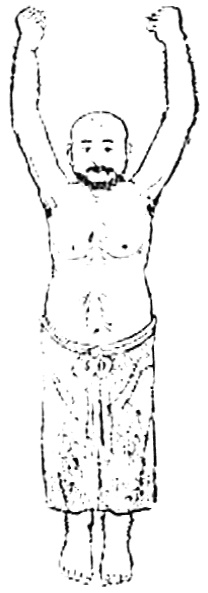
倜按
Commentary:
此乃練全身筋骨之法。兩臂上舉。則肩背胸廓。處處着力。兩足上舉。則腿胯等處。處處不虛。若腿胯不用全力。則身體必動搖不定。難行之矣。至兩臂蓄力下挫。非眞將兩臂下挫。但使兩臂之力向下挫。而臂仍不動。此運意使力之法也。足跟落下時。宜緩緩着地。不能猛疾。過猛過疾。則踵與地相扣。則全身血脉。必受激震。而心房且受其患。切宜愼也。
This exercise develops the strength of the whole body, your lifted arms working your shoulders, back, and chest, your lifted heels working your legs and hips. If your legs and hips do not exert their full strength, then your body will wobble unstably and make the exercise difficult. Your arms tensing downward does not mean they are lowering, but that they are pulling down without moving, using an intention of moving to create tension. When your heels come down, they should lower slowly rather than abruptly. If your heels drop down heavily, it will give a jolt to the blood vessels throughout your body and startle your heart. Give attention to this point.
–
△第六段
Section 6:
行上段畢。略息片時。續行此段。先將兩足分開。相距約一尺。須平直。不宜作八字式。兩手握拳。拇指並不置拳心中。曲置于外。其第二節。與其餘四指之地一節。緊緊相扣。然後從左右舉起。至上臂與肩平時。卽折肘向內。折至極度。拳對兩耳。相離寸許。臂宜舉平。最忌前後傾倒。上下欹斜。掌心向肩。將拳緊握一下。小用力向內折。上臂蓄力向上抬。如此拳一握。臂一折一抬為一度。默數牢記。共行四十九度而止。式如第六圖。
Continuing from the previous exercise, take a moment to regulate your breath, then continue into Section 6. With your feet spread about a foot apart [though the drawing shows them still together], pointing straight and parallel rather than with the toes turned outward, your hands grasp into fists, but with your thumb drawn outward to be tightly clamping down over the joint of just the forefinger rather than curling over the fingers to the center of the fist. Then your fists lift from the sides until your upper arm is at shoulder level, whereupon your elbows bend inward as far as they can so that your fists are about an inch away from your ears. Your arms should be directly to the sides, not shifting forward or back, up or down. With the centers of the fists [the fist mouths] facing toward your shoulders, your fists squeeze and your forearms tense to bend further inward, your upper arms tensing upward against them. Perform the exercise in this way, with your fists squeezing, your forearms tensing inward, and your upper arms tensing upward, for a total of forty-nine times, counting silently in your head. See drawing 6:

倜按
Commentary:
此段乃練肘腕之力。而兼及于胸廓肩背者也。小臂內向。則肘折而筋骨緊張。握拳向耳。拳高向肩下挫。手腕必折轉而運用其力。臂舉平肩。胸廓開展。內臟必然伸舒。上臂于小臂內折時上抬。則肩與背亦處處着力矣。行此之時。上體最忌欹斜動搖。兩腿尤須用力。以固下盤。
This exercise develops strength in the elbows and wrists, as well as in the chest, shoulders, and upper back. With your elbows bent, create tension in the muscles of your forearms. Your fists go toward your ears and downward to try to touch your shoulders, causing the wrists to bend and exert strength. With your arms placed to the sides, your chest opens, making your internal organs comfortable. As your upper arms tense upward against your forearms, create tension also in your shoulders and upper back. During the exercise, your upper body must avoid wobbling in any direction. Your legs should tense to keep you standing stably.
–
△第七段
Section 7:
行上式畢。略息片時。續行此段。先將兩手握拳。拇指在外。其第二節與其餘四指之第一節相扣。提至當胸。掌心向內。肘臂與肩平。然後用力緩緩向左右分去。平肩成一字式。上身略向後仰。惟體不能曲。足跟着地足尖上抬。以離地盈寸為度。將拳緊緊一握。緩緩一鬆。拳緊則吸氣入內。拳鬆則吐氣向外。如此一緊一鬆為一度。默數牢記。共行四十九度為止。式如第七圖
Continuing from the previous exercise, take a moment to regulate your breath, then continue into Section 7. First your hands grasp into fists, the thumbs now covering over the rest of the fingers, and lift up until in front of your chest, the centers of the fists facing inward, the arms at shoulder level. Then they slowly spread apart to the sides, maintaining tension throughout, to form a single line at shoulder level. Your upper body slightly leans back, though your body must not go to the point that it is actually bending back. Your heels are on the ground, but your toes lift up an inch off the ground. Your fists grip tightly and slowly loosen. As your fists grip tightly, inhale. As your fists loosen, exhale. Tighten and loosen for a total of forty-nine times, counting silently in your head. See drawing 7:
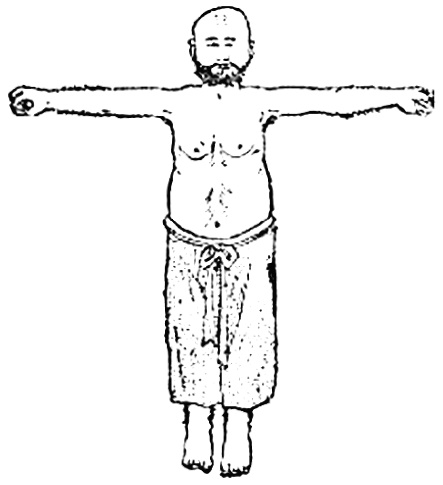
倜按
Commentary:
此段乃練拳臂之力而兼理其內臟之法也。握拳伸臂。所以增其力。吸氣吐氣。所以理其臟腑。卽習吐納術者之所謂。納淸吐濁也。且欲理內臟。必先使其內部開展舒適。然後有效。此段之所以伸兩臂而仰身向後者。正使其胸廓張大而展其內臟也。然後更納淸氣而吐濁氣。則獲益自可想見。至足尖上抬。蓋欲使兩腿着力而不至鬆懈。若不着力則傾跌立見。用意深遠矣。
This exercise develops strength in the fists and arms, and also regulates the internal organs. Your fists gripping and your arms extending increases strength. Inhaling and exhaling regulates your organs by way of “expelling stale air and taking in fresh”. In order to regulate your organs, you first have to get the inside to be stretched out and comfortable, and then it will be effective. Reaching out your arms and leaning your upper body back causes your chest to open and invigorates your internal organs. By then adding the expelling of stale air and taking in fresh air, the benefits will be noticeable. As for your toes lifting, engage the strength of your legs and do not let it slacken, otherwise you will teeter. Keep your mind deeply focused.
–
△第八段
Section 8:
此與第四式大略相同。行上畢段。略息片時。續行此段。兩手曲拇指于掌心。更以餘指握之成拳。然後從下前方直舉高與肩平。兩拳心相對。惟第四式之相距。以與肩闊相等。此則相距止二三寸之遙。兩拳上舉時。兩足踵卽向上提。完全用足趾點地。足踵離地約二三寸。然後將拳緊緊一握。徐徐一鬆。一握一鬆為一度。默數牢記。共行四十九度而止。式如第八圖。
This section is the same general idea as in Section 4. Continuing from the previous exercise, take a moment to regulate your breath, then continue into Section 8. Your hands grasp into full fists and go forward from below, rising up to shoulder height, the centers of the fists facing each other. In Section 4, your fists were shoulder width apart, but in this exercise they are only about a quarter of a foot apart. As your fists rise up, your heels lift about a quarter of a foot off the ground so that the balls of your feet are entirely supporting you. Then your fists grip tightly and slowly loosen. Grip and loosen for a total of forty-nine times, counting silently in your head. See drawing 8:

倜按
Commentary:
此段乃練兩臂凌空之力者。緊緊握拳之後。兩臂宜力向外分。至與肩闊相等時為度。蓋作拉引重物之勢也。拳距等肩後。卽將拳徐徐鬆開。兩臂仍緩緩合攏。至原處而止。如是行之。其效最著。學者不可不知
This exercise develops strength in the arms for creating space. Once your fists squeeze, your arms spread apart with tension until they are at shoulder width, as though prying heavy objects apart. Once your fists reach shoulder width, they slowly loosen, then your arms slowly move inward again to come back to their original spacing. Practicing in this way will produce marvelous results that you will not fail to notice.
–
△第九段
Section 9:
行前段畢。略息片時。續行此段。先兩足緊並。不宜作八字式。全身直立。頭正目前視。兩手先曲拇指于掌心。將餘指握之成拳。然後屈肘將兩臂上提。以拳臂肩相平為度。此時拳心向下。兩拳相距約二三寸。更將兩拳緊緊一握。小臂上舉。腕用力向上翻轉。至掌心向外。兩拳向鼻為度。惟兩拳不能捧鼻。須離開約盈寸地。腕及小臂上翻之時。上臂不宜隨之上抬。然後將拳徐徐鬆開。小臂肘腕。仍復原位。為此一翻一落為一度。默數牢記。共行四十九度而止。式如第九圖。
Continuing from the previous exercise, take a moment to regulate your breath, then continue into Section 9. Stand straight with your feet together, your feet pointing straight rather than with the toes turned outward, your head upright, your gaze forward. Your hands form full fists, then your elbows bend and your forearms lift up until your fists and forearms are at shoulder level. The centers of the fists are facing downward, about a quarter of a foot apart. Then your fists squeeze and your wrists and forearms rotate upward with tension so that the centers of the fists are facing outward, your fists moving toward your nose, but staying at least an inch away from it. As your wrists and forearms rotate upward, this should not cause your upper arms to move upward. Then your fists slowly loosen as your forearms and wrists return to their original position. Rotate upward and back downward for a total of forty-nine times, counting silently in your head. See drawing 9:
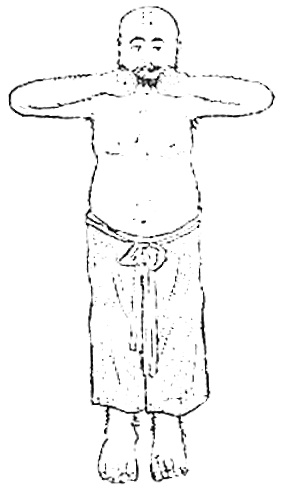
倜按
Commentary:
此段乃練肘部之力。而兼及兩臂之法。其翻腕向上時。宜如手握千鈞之物。向上翹起。雖手中並未握物。心目中當作如是觀。否則任意行之。則力不專注。獲益實鮮。且此段坊本作兩臂上提時。拳卽對鼻。腕臂並不翻落。但將拳握放者實誤。蓋如是非但獲益甚少。且與第六式相混。殊不合理也。學者宜審思而明辨之。
This exercise develops strength in the elbows and forearms. As your wrists rotate upward, your hands should seem to be holding a heavy object that they are trying to lift by way of rotation. Although you are not actually holding an object, your mind has to treat it as though you are. Otherwise you would be moving arbitrarily, the tension would not be concentrated, and the benefits you receive would be reduced. Other versions have the arms lifting up with the centers of the fists facing inward rather than downward, improperly releasing the tension in the fists. Not only would you receive less benefit doing it in that way, the exercise may also become confused with Section 6, which actually has a very different principle. You have to scrutinize and be able to discriminate between authentic and inauthentic versions.
–
△第十段
Section 10:
行上段畢。略息片時。更續行此段。先兩足緊並。全身正立。屈拇指于掌心。以餘指握之成拳。然後折肘將兩臂從前面上舉。使上臂與肩平。小臂直竪左右。拳口對耳。掌心向前。使兩臂與頭。成一山字形。將拳一緊握。兩臂蓄力向上托。為舉重物狀。兩肘蓄力向外逼。意欲使之凑合。然後徐徐將拳鬆開。收囘肘臂之力。如此一握放為一度。默數牢記。共行四十九度而止。如式第十圖。
Continuing from the previous exercise, take a moment to regulate your breath, then continue into Section 10. Stand straight with your feet together, your hands forming full fists. Your elbows bend and your arms lift upward until your upper arms are at shoulder level, your forearms vertical, the fist mouths facing your ears, the centers of the fists facing forward, your arms and head making a posture that looks like 山 [the character for “mountain”]. Then your fists squeeze and your arms create a tension of propping upward as though holding up a heavy object, while your forearms have a tension of resisting against an outward pressure, all of these tensions driven by intention, and then slowly loosen your fists and relax your arms. Grip and release in this way for a total of forty-nine times, counting silently in your head. See drawing 10:
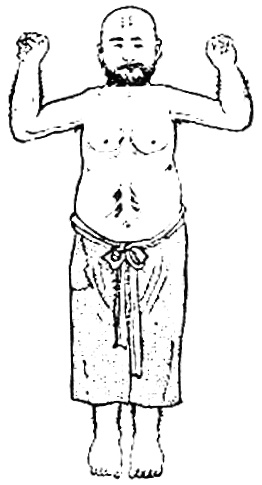
倜按
Commentary:
此段乃練兩臂上托之力。所謂臂蓄力上托。肘蓄力外逼者。非眞須將臂上托時外逼也。亦運意使力之法。卽拳技家所謂力到拳不到之意。蓋意想所及。使兩臂之力向上托。兩肘之力向外逼也。坊本作臂上舉時外逼。則勢亂而力散矣。殊覺其誕謬。學者宜愼察之。
This exercise develops arm strength for propping up, using a tension of propping upward while the forearms have a tension of pressing outward, though it is not actually necessary to press outward while propping upward. The tension is driven by intention, what boxing arts masters call “an intention of strength reaching and yet not reaching the fist”, because strength should only arise where intention goes, [rather than manifesting undirected]. Other versions involve an outward resistance as soon as the arms are lifting up, making the posture awkward and the tension unfocused, causing the exercise to feel exaggerated. Carefully observe the difference.
–
△第十一段
Section 11:
行前段畢。略息片時。續行此段。先兩足緊並。全身正立。兩手握拳。拇指第二節與餘四指第一節。緊緊相扣。然後將雙拳緩緩提至少腹之上。臍輪之下。肘微屈。拳離腹盈寸。將拳緊握一下。拇指卽向上一翹。而兩臂蓄力使上提。如提千鈞重物。然後徐徐鬆拳。拇指仍屈至原處。每于拳緊時。吸氣向內。拳鬆時吐氣向外。如此一緊一鬆者一度。默數牢記。四十九度而止。
Continuing from the previous exercise, take a moment to regulate your breath, then continue into Section 11. Stand straight with your feet together, your hands forming full fists. Your fists slowly lift over your abdomen until just below your navel, your elbows slightly bending, your fists at least an inch away from your abdomen. Your fists squeeze with your thumbs rising up, your arms having a tension of lifting up, as though they are holding up a heavy object, and then your fists loosen as your thumbs wrap over them again. When your fists squeeze, inhale. When your fists loosen, exhale. Squeeze and loosen in this way for a total of forty-nine times, counting silently in your head. See drawing 11:

拳足復原位。靜心屛息。默誦呵噓呼呬吹嘻六字九遍。式如第十一圖。
With your fists and feet returning to their original position, calm your mind and do this breathing exercise: quietly recite the six sounds of “he, xu, hu, xie, chui, xi” nine times.
倜按
Commentary:
此段練拔之力。而理內臟之法。納淸吐濁。使腹內淸潔。至呵噓呼呬吹嘻六字。乃治臟之不二妙訣。治心宜呵。治肝宜噓。治脾宜呼。治肺宜呬。治腎宜吹。治三焦宜嘻。其所以必先納淸吐濁而後行之者。先淸其內臟而後按部調理之也。行九遍者按九宮也。默誦之時。聲音宜低。每字須延長至一呼吸時。若音高而短。則氣促神渙。是為最忌。切宜留意。
This exercise develops strength for pulling things up and is also a method of regulating the internal organs by way “expelling stale air and taking in fresh”, thereby cleansing the abdomen. The six sounds of “he, xu, hu, xie, chui, xi” are a mantra for regulating the organs, the sound “he” being associated with the heart, “xu” with the liver, “hu” with the spleen, “xie” with the lungs, “chui” with the kidneys, and “xi” with the triple warmer. It is necessary to first expel stale air and take in fresh, cleansing the abdomen, and then the functioning of the organs can be regulated. Doing this slow mantra nine times represents the “nine palaces” [each of the eight trigrams plus the center]. When quietly reciting these sounds, the sound should be low and drawn out over the course of a full breath. If the sound is high and quick, you will become short of breath and lose your focus. Be careful to avoid doing this.
–
△第十二段
Section 12:
行上段畢。略息片時。續行此段。先兩足緊並。全身正立。兩臂直垂左右。雙掌向前。指尖朝下。然後用力徐徐向前舉起。平肩為度。在兩臂上舉時。兩足踵亦卽向上舉起。足尖着力。踵離地約二寸。更將兩手徐徐放下。兩踵亦輕輕落地。如此一起一落為一度。共行十二度。
Continuing from the previous exercise, take a moment to regulate your breath, then continue into Section 12. Stand straight with your feet together, your arms handing down at your sides, the palms facing forward, the fingers hanging downward. Your arms then slowly go forward with tension, lifting up until at shoulder level. As your arms lift up, your heels also rise up about a quarter of a foot away from the ground, the balls of your feet supporting you. Then your hands slowly lower as your heels come back down. Rise and lower in this way for a total of twelve times. See drawing 12:

旣畢。再舉掌于前如前勢。將肘一折。手掌往上一抬。肘卽往下一扎。上舉之左足。輕輕落地。再復原勢。然後再一抬一扎。左足踵上舉。右足輕輕落地。兩足替換上下。以一抬一扎為一度。共行十二度。式如第十二圖。
Then your hands go forward again and your elbows bend, causing your palms to lift up and your elbows to poke downward, as your left heel rises up and then gently comes back down, and you return to your original position. Lift up and poke down again, your right heel rising up and then gently coming back down. With your feet alternating, your hands lift up and your elbows poke down for a total of twelve times.
倜按
Commentary:
此段乃舒展全身筋絡血脉之法。蓋行以上十一勢之後。臂肘腿足內臟各部。固皆用力運氣。筋絡伸舒而血脉調和矣。于頸臀等處。雖亦顧及。然不免偏輕。故用此法而調和之。兩臂起落抬扎。兩踵上下交替。則全身之筋絡血脉。無不感應自然調和舒展矣。其所以各行十二度者。按十二候也。合之成二十四度。暗應二十四氣也
This two-part exercise stretches the sinews and vessels of the whole body. After Section 11, your arms, legs, and torso all use tension and the movement of energy to stretch the sinews and regulate the vessels. Although you may give attention to everything from head to hips, there will unavoidably be parts that are emphasized more than others, and therefore use this exercise to balance everything out. Your arms rise and lower, then lift up and poke down, your heels rising and lowering, alternating left and right, and thus the sinews and vessels of your whole body will naturally get stretched and regulated. Both parts of this exercise are done twelve times, representing the “twelve hours” throughout the day [11pm–1am, 1am–3am, 3am–5am, 5am–7am, 7am–9am, 9am–11am, 11am–1pm, 1pm–3pm, 3pm–5pm, 5pm–7pm, 7pm–9pm, 9pm–11pm] and when combined together amount to twenty-four repetitions, representing the “twenty-four periods” throughout the year [start of spring, first rains, “waking hibernators”, vernal equinox, “fresh and shining”, rain for crops, start of summer, “small fullness” (referring to crop growth), “bearded crop” (i.e. rich yield), summer solstice, small heat, big heat, start of autumn, lingering heat, fresh dew, autumnal equinox, cold dew, frost arrives, start of winter, small snow, big snow, winter solstice, small cold, big cold].
–
–
–
